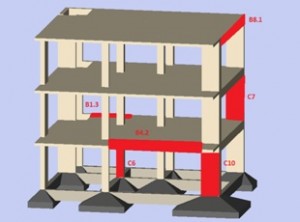
Post-earthquake structural repair methods of reinforced concrete buildings
The main objectives of the present dissertation is to establish and prove that apart from the empirical and theoretical preliminary design study that is usually applied in order to determine an adequate repair material for repairing reinforced concrete structures damaged by earthquakes, there is also a more advanced procedure which is accomplished by means of extensive analysis with the aid of dedicated software based on recent codes and regulations.
The dissertation is composed of three major parts. The first part is the theoretical research, which has as objective to provide in a combinatorial and simultaneously harmonic way, all the required information collected after the studying of various sources that the reader would require to comprehend in order to understand the software based analysis, application and results of structural repair methods in an earthquake damaged structure that follows in the second part. . It should also be noted that the repair methods chosen to be analyzed in the theoretical research, are the ones covered by the software (shotcrete, epoxy resins, FRP composite materials).
The second part includes the first stage of the software analytical component of the dissertation. With the aid of the professional design software Master 10 EC Fespa which operates primarily based on the latest editions of Eurocodes, an appropriate selected RC building located in an area with high and frequent seismic will undergo repair design analysis. At this stage the analysis will contain: i) the graphically representation of the building in the software, ii) the identification and fault type classification assignment on each of the building’s harmed elements iii) non-linear static (pushover) analysis to estimate the pre-repair structure behavior comparing the earthquake response of the building with the seismic stresses of the area, iv) the selection of the appropriate repair method for each hurt element.
The third major part contains the second stage of the software analysis. All the building data are inputted, the re-design of the under repair elements using the specified methods is taking place, and results regarding the new repaired elements design properties are generated. These properties are compared with the ones of their pre-repair state, and the significance of the findings are discussed. Finally the repaired now building will undergo pushover analysis again, so that it will be possible to compare and comment the pre-repair and post-repair behavior state, and to determine the effectiveness of the selected repair methods.
After a research like this, a wealth of theoretical information and software analysis outcomes are obtained, which in combination with personal knowledge and experience, that may be achieved after extensive study of literature, regulations and directives, could aid to the selection of an appropriate repair material and implementation method in order to achieve the maximum possible restoration-repair successfulness of the critical property (e.g. shear, bending moment) of each earthquake damaged structural element.



